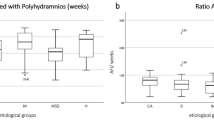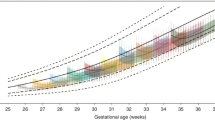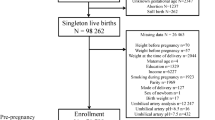Abstract
A total of 4 of 153 low birth weight infants at our hospital were found to have pseudo-Bartter syndrome in 2005 and 2006. The neonates (two of whom were twins; light for gestational age 2, appropriate for gestational age 1 and small for gestational age 1) showed symptoms of apnea and/or poor feeding or patent ductus arteriosus, which disappeared by day 4. Hypokalemia, hypochloremia and metabolic alkalosis normalized by day 8. The mothers had repeatedly rushed to the restroom after eating while in hospital, and were lighter at delivery than before pregnancy; however, vomiting was not observed. The mothers had several stress factors related to pregnancy, and all recovered from the eating disorder after delivery. Urinary Cl/creatinine (mequiv. mg−1) and serum Mg in the infants were <0.1 and 1.6 to 2.3 mg per 100 ml, respectively. Eating disorder during pregnancy may have caused Bartter-like syndrome and weight loss, and led to the same syndrome and intrauterine growth retardation in the offspring. Therefore, a hidden maternal eating disorder may underlie neonatal pseudo-Bartter syndrome.
This is a preview of subscription content, access via your institution
Access options
Subscribe to this journal
Receive 12 print issues and online access
$259.00 per year
only $21.58 per issue
Buy this article
- Purchase on Springer Link
- Instant access to full article PDF
Prices may be subject to local taxes which are calculated during checkout
Similar content being viewed by others
References
Mathot M, Maton P, Henrion E, François-Adant A, Marguglio A, Gaillez S et al. Pseudo-Bartter syndrome in a pregnant mother and her fetus. Pediatr Nephrol 2006; 21: 1037–1040.
Ogawa Y, Iwamura T, Kuritani N, Nishida H, Takeuchi H, Takada M et al. Japanese referential range for birth weight and height at each gestational week. J Japan Soc Neonatol 1998; 34: 624–632.
Dell KM, Avner ED . Bartter syndrome. In: Behman RE, Kliegman RM, Johson HB, Saunders RE (eds). Nelson Textbook of Pediatrics. 17th edn, Saunders: Philadelphia. 2004 p 1763.
Mersin SS, Ramelli GP, Laux-End R, Bianchetti MG . Urinary chloride excretion distinguishes between renal and extrarenal metabolic alkalosis. Eur J Pediatr 1995; 154: 979–982.
Gross S, Librach C, Cecutti A . Maternal weight loss associated with hyperemesis gravidarum: a predictor of fetal outcome. Am J Obstetr Gynecol 1989; 160: 906–909.
Abreu e Silva FA, MacFadyen UM, William A, Simpson H . Sleep apnea during upper respiratory infection and metabolic alkalosis in infancy. Arch Dis Child 1986; 61: 1056–1062.
Live births. Maternal and Child Health Statistics of Japan 2006. Mothers' & Children's Health Organization: Tokyo, 2007 pp 42–45.
Author information
Authors and Affiliations
Corresponding author
Rights and permissions
About this article
Cite this article
Higuchi, R., Sugimoto, T., Hiramatsu, C. et al. Neonatal pseudo-Bartter syndrome due to maternal eating disorder. J Perinatol 28, 646–648 (2008). https://doi.org/10.1038/jp.2008.68
Received:
Revised:
Accepted:
Published:
Issue Date:
DOI: https://doi.org/10.1038/jp.2008.68
Keywords
This article is cited by
-
Le syndrome de pseudo-Bartter néonatal dû à des désordres alimentaires maternels: peut-être plus fréquent qu’il n’y paraît
Revue de médecine périnatale (2012)



